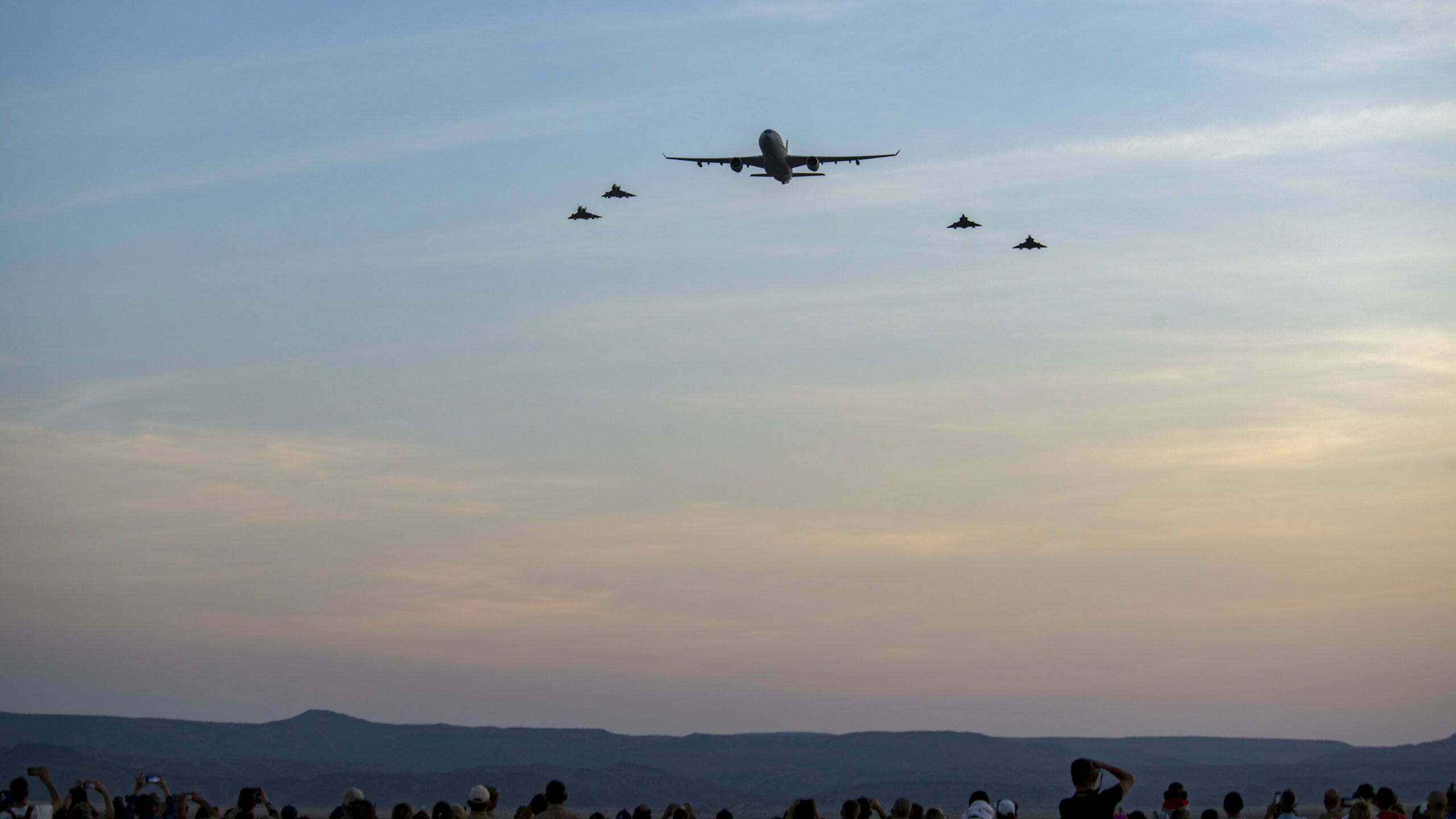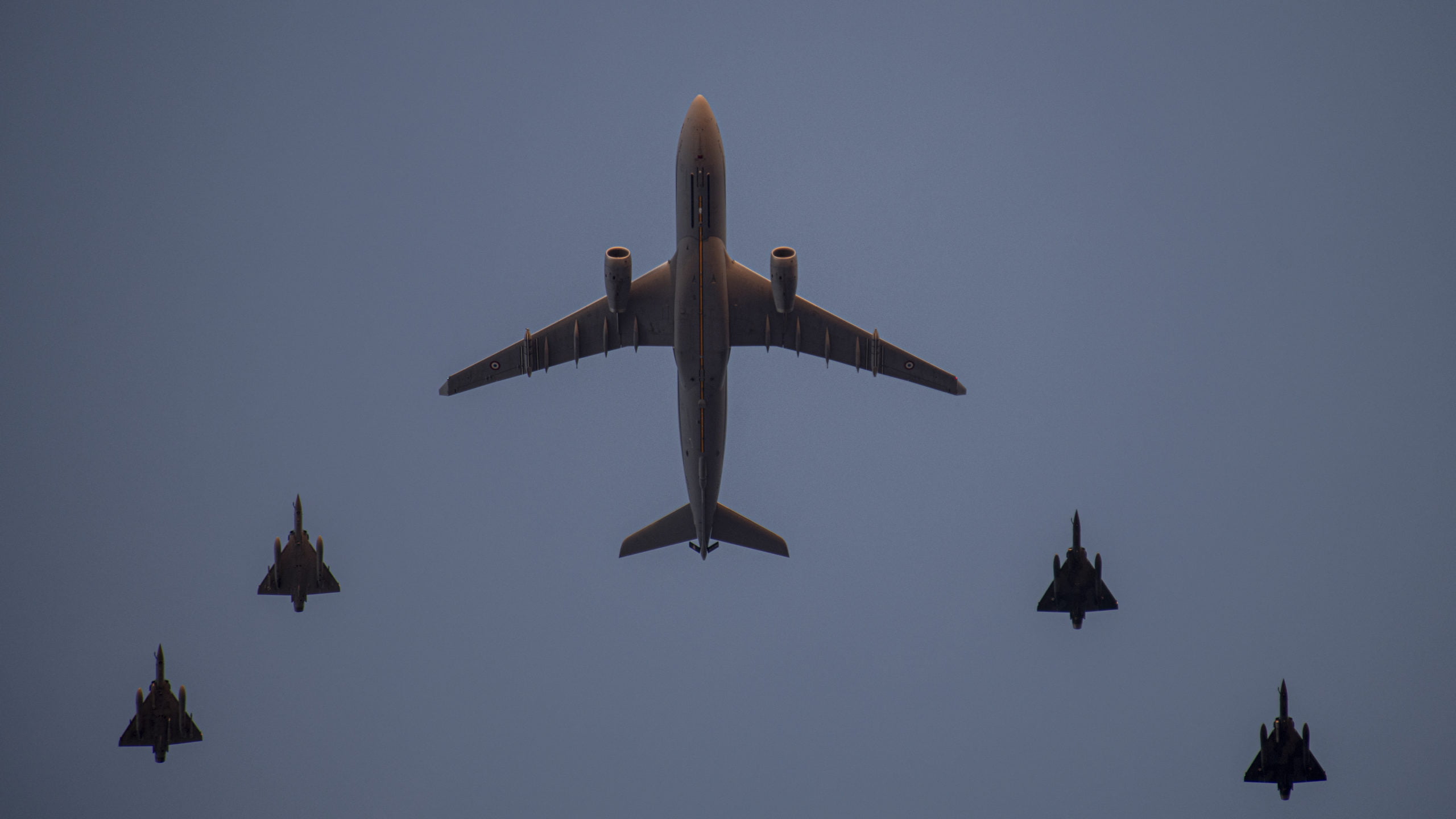By Pierre Tran
October 31, 2023
Paris – France signed Oct. 6 a contract with Airbus Defence and Space to add a secure, high-speed satellite communications link to the A330 multirole tanker transport, a deal the company sees as plugging MRTT jets into a network of a planned European future combat air system.
“The DGA (Direction Générale de l’Armement) awarded Oct. 6 2023 the company Airbus Defence & Space the first stages of work on standard 2 on the A330 Multi Role Tanker Transport (MRTT) Phénix of the French air and space force,” the armed forces ministry said in an Oct. 20 statement.
Airbus D&S also signed Oct. 6 a contract for 10 years’ service, with option for two more years, for the MRTT, the company said in an Oct. 23 statement, with the standard 2 communications and maintenance deals worth a total €1.2 billion ($1.3 billion).
Airbus D&S is effectively prime contractor for installing standard 2, which relies on a Thales onboard satellite link dubbed Melissa, and service for the French MRTT fleet. A company spokesman declined to say how that total amount was split between the two MRTT deals.
The standard 2 communications upgrade is seen as delivering an entry to a planned combat cloud extended network, for the MRTT, a military conversion of the Airbus A330-200 wide-body, twin-engine airliner. “This new standard, which will undergo incremental development, strengthens the capability of the A330 MRTT to evolve in contested environments, while providing greater communications capability with other aircraft and command centers,” the ministry said.
The DGA procurement office and Direction de la Maintenance Aéronautique (DMAé), the aeronautics service unit, also signed Oct. 6 with Rolls-Royce a maintenance contract for up to 20 years for the Trent 700 engine on the MRTT, with the British company delivering its MissionCare service.
Lockheed Bales Out
The Airbus D&S Oct. 23 statement on the MRTT deals coincided with Lockheed Martin’s announcement the American company was pulling out of the U.S. air force competition for an air tanker.
Lockheed had partnered with Airbus for the European company to pitch its A330 MRTT, and that departure left Airbus flying solo against Boeing, its archrival in the U.S. tender for some 75 inflight refuelling jets, worth an estimated $12 billion.
France attaches strategic importance to its MRTT fleet, which provides inflight refuelling for the Rafale, boosting the range of the fighter which carries the airborne deterrent, the ASMP/A nuclear-tipped missile.
The Phénix MRTT replaced the U.S.-built French air force fleet of 11 C-135FR and three KC-135RG, which dated back to the 1960s, flown by the Brétagne squadron. Those French air tankers supported the Mirage IV and 2000N, and more recently Rafale, armed with nuclear weapons. Phénix also replaced three A310 and two A340 jets flown by the Esterel transport squadron.
The then U.S. president, John F. Kennedy, authorized the sale of the C-135 when his French counterpart, Charles de Gaulle, was building an independent nuclear strike, said an analyst at the Institut Français d’Analyse Stratégique, a think tank.
The first phase in the standard 2 upgrade includes equipping the MRTT with a defensive aids sub-system, the ministry said, without giving details. The Airbus D&S spokesman declined to comment.
The French authorities see selection of the defensive sub-system as highly sensitive and has that wrapped up in strict confidentiality. U.S. and Israeli companies lead the market for defensive sub-systems. The Nato multinational fleet of nine MRTT, backed by six member states, is fitted with a direct infrared countermeasures (DIRCM) system from Elbit Systems, dubbed J-Multi Spectral Infrared Countermeasure or J-Music. The German Air Force has also equipped its A400M airlifters with J-Music kit. The system aims to protect aircraft from ground-based, heat-seeking missiles.
Meanwhile, talks are being held for selecting subcontractors for service support, an industry source said. Companies such as Collins Aerospace and Sabena Technics are active in the French service market.
Maintenance, repair and overhaul may be low key but that business offers a steady flow of income, while requiring technical skill. The risk and reward of service contracts could be seen with the French fleet of C-130 Hercules airlifters, which in the past suffered from low availability, stemming from what the then head of air force special operations command said was due to industrial problems. A Portuguese company, Ogma, previously provided service for the French C-130 fleet.
The separate and complementary service contracts for the MRTT airframe and aero-engines reflect the “vertical” approach of the DMAé, the ministry said, and the commitment of work for at least 10 years gave reassurance for the companies to invest €30 million in infrastructure around Istres air base.
Changes The Game
Standard 2 is a “game changer,” the analyst said, as the MRTT aircraft adds “multimission” to its support for the French strategic airborne force and flying logistical support for overseas deployment.
The defense ministry gave no details on the value of the standard 2 contract. The DGA was not available for comment.

The satellite communications link will be retrofitted to the 12-strong MRTT fleet flown by the French air force from Istres air base, close to Marseille, southern France. A further three MRTT jets are due to join the fleet by 2030, with the 15th unit to be the prototype for standard two, due for certification in 2028.
Standard 2 aims to plug MRTT into the planned combat cloud, one of the critical technology pillars being developed for the European future combat air system. “With this new capability of the aircraft, we are preparing the future by transforming the MRTT into an in-flight communications node, as the first building block of the Multi Role Tanker Transport of tomorrow, embedded in the Future Combat Air System (FCAS),” Jean-Brice Dumont, head of military air systems at Airbus Defence & Space said in the Oct. 23 statement.
Connectivity through telecommunications is seen as a major capability, and the MRTT will be fitted with a satellite communications link, dubbed Melissa, allowing the tanker-transport to hook up to the French Syracuse IV military satellite network.
The Melissa satcom will allow the MRTT to be connected at all time, beating enemies’ jamming attempts and extreme weather, the company said. The MRTT standard 2 will deliver “high-bandwidth communication, sovereign and secure,” to boost links with the airborne deterrence, the ministry said. MRTT will hold a “central position in aeronautical connectivity,” providing a communications node between C2 command and control and the aeronautic network. The Airbus team in France will be doubled to support the MRTT activities, the company said.
Melissa Boosts Links
On the Melissa communications link, Thales said Feb. 8 2022 the company would deliver the onboard satellite workstation in 2025, offering high bandwidth, high availability, and high performance on large military or government aircraft such as MRTT, A400M, and Awacs spy planes.
The contract for a military system linked to Syracuse IV satellite is for 17 years and is based on a civilian system, which has shown reliability with more than 30,000 flight hours, the company said. “This military version is specially designed to maintain connectivity with commanders in a jammed environment or in very poor flight or weather conditions,” the company said. The link can work with “the sovereign Syracuse IV satellites and is also compatible with other allied military or commercial satellites.”
The present French MRTT fleet uses Link 16 for communications with Nato allied aircraft and commanders.
The air force flies 12 MRTT tanker transports, and three more aircraft are due to be delivered by 2030 under the 2024-2030 military budget law, adopted in July. Development work on standard 2 will lead to the qualification of the prototype, the ministry said, with the remaining fleet retrofitted as they undergo routine service over the 10 years contracted with Airbus DS.
The first MRTT to be converted to standard 2 will be number 15 for the French air force, with the conversion to be made at the Airbus Getafe plant, in Spain, Airbus DS said. That MRTT is due to be qualified in 2028. The other MRTTs will be retrofitted at Istres air base.
The MRTT, which entered service in 2018, also serves as a flying hospital for medical evacuation missions.
In the air force’s Pegase 23 mission, the service flew five A330 MRTT, along with 10 Rafale and four A400M airlifters to the Pacific region in 72 hours. The service plans for the next air deployment to consist of a full 20-strong Rafale squadron, supported by 10 A330 MRTT tankers, reaching the Pacific in 48 hours.


